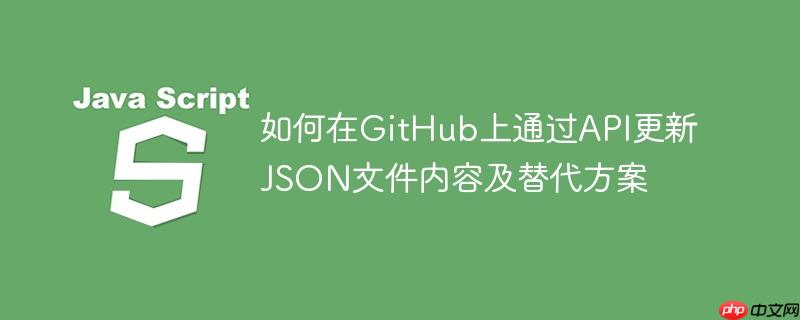
许多开发者尝试直接通过客户端javascript(如使用axios库)向github pages上托管的json文件发送post请求以更新其内容,但通常会遇到跨域资源共享(cors)策略阻碍,并收到类似“access to xmlhttprequest at '...' from origin '...' has been blocked by cors policy: response to preflight request doesn't pass access control check: no 'access-control-allow-origin' header is present on the requested resource.”的错误。
出现此问题的原因主要有两点:
如果确实需要通过程序化方式修改GitHub仓库中的文件,正确的途径是使用GitHub提供的REST API。GitHub API设计用于管理仓库、文件、提交、分支等所有GitHub功能。
GitHub API中专门有一个接口用于创建或更新仓库中的文件内容,其文档地址通常可以在GitHub开发者文档中找到,例如PUT /repos/{owner}/{repo}/contents/{path}。
接口特点:
由于安全原因(不应在客户端代码中暴露GitHub PAT),以下示例更适合在服务器端(例如Node.js、Python后端服务)执行。客户端可以向你的后端服务发送请求,由后端服务负责与GitHub API交互。
const axios = require('axios'); // 假设在Node.js环境
async function updateGitHubFile(owner, repo, path, newContent, token) {
const apiUrl = `https://api.github.com/repos/${owner}/${repo}/contents/${path}`;
try {
// 1. 获取当前文件内容及SHA(如果文件存在)
let currentSha = null;
try {
const response = await axios.get(apiUrl, {
headers: {
'Authorization': `token ${token}`,
'Accept': 'application/vnd.github.v3+json'
}
});
currentSha = response.data.sha;
console.log(`Current file SHA: ${currentSha}`);
} catch (error) {
if (error.response && error.response.status === 404) {
console.log('File does not exist, will create a new one.');
} else {
throw new Error(`Error fetching current file: ${error.message}`);
}
}
// 2. 准备新的文件内容(Base64编码)
const base64Content = Buffer.from(JSON.stringify(newContent, null, 2)).toString('base64');
// 3. 构建PUT请求体
const requestBody = {
message: 'Update JSON data via API',
content: base64Content,
sha: currentSha // 如果是创建新文件,则不包含sha字段
};
// 4. 发送PUT请求更新文件
const updateResponse = await axios.put(apiUrl, requestBody, {
headers: {
'Authorization': `token ${token}`,
'Content-Type': 'application/json',
'Accept': 'application/vnd.github.v3+json'
}
});
console.log('File updated successfully:', updateResponse.data.commit.html_url);
return updateResponse.data;
} catch (error) {
console.error('Error updating GitHub file:', error.response ? error.response.data : error.message);
throw error;
}
}
// 使用示例(请替换为你的实际信息)
// const owner = 'your-github-username';
// const repo = 'your-repository-name';
// const path = 'path/to/your/tiles.json';
// const githubToken = 'YOUR_GITHUB_PERSONAL_ACCESS_TOKEN'; // **切勿在客户端代码中硬编码或暴露!**
// const newData = [{ id: 1, name: 'New Item' }, { id: 2, name: 'Another Item' }];
// updateGitHubFile(owner, repo, path, newData, githubToken)
// .then(() => console.log('Operation complete.'))
// .catch(err => console.error('Failed to update file.'));注意事项:
对于需要动态存储和管理数据的应用,尤其是在生产环境中,尝试将GitHub文件作为数据库来使用并非一个理想的方案。最推荐且最健壮的解决方案是部署一个专门的后端服务并配合数据库使用。
架构优势:
典型流程:
总结:
直接通过客户端JavaScript向GitHub Pages上的JSON文件发送POST请求以修改其内容是不可行的,这既是静态托管服务的特性所限,也是出于安全考量。若必须程序化修改GitHub仓库文件,应使用GitHub API,但强烈建议在服务器端执行以保护认证凭据。对于需要动态数据存储的场景,最专业和安全的实践是搭建一个独立的后端服务,并配合数据库进行数据管理。
以上就是如何在GitHub上通过API更新JSON文件内容及替代方案的详细内容,更多请关注php中文网其它相关文章!

每个人都需要一台速度更快、更稳定的 PC。随着时间的推移,垃圾文件、旧注册表数据和不必要的后台进程会占用资源并降低性能。幸运的是,许多工具可以让 Windows 保持平稳运行。

Copyright 2014-2025 https://www.php.cn/ All Rights Reserved | php.cn | 湘ICP备2023035733号